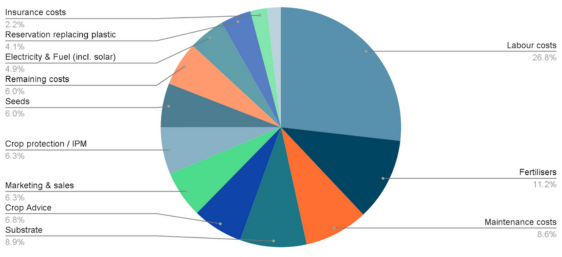Costs & Considerations of Greenhouse Farming
We’re in the business of growing your growing business.
When it comes to farming, success isn’t just about what you grow—it’s about how you grow it.
Money out, money in.
Expenses, profits.
If you can reduce the former, you’ll increase the latter
It may seem like a simple premise. But knowing how to reduce greenhouse expenses without sacrificing or threatening your yield is more complex than it seems. Setting up a greenhouse is far more than a construction project; it’s the beginning of a long-term business venture.
We’ve built a strong 30-year reputation for engineering high-quality greenhouse structures. In this time, we’ve gained valuable expertise on the economic viability and sustainability of a farming operation and how to help our customers achieve it.
As a business, farming involves several investments, both CAPEX and OPEX, and each environment and crop will have unique requirements and associated costs.
Here, we’ll outline the costs and considerations of a typical operation to give you a better idea of what you’re in for. It’s a big investment, however you do it, but yields far greater success and profit if done correctly.
So, let’s dive in.
The Business of Farming - More than Just Greenhouse Construction
Many view greenhouse farming as an infrastructure investment — building a structure and filling it with crops. But at Vegtech Netafim, we’ve learnt that to truly succeed in greenhouse farming, you must think about the entire lifecycle of your project. This includes not only the initial setup costs, known as CAPEX (capital expenditure), but also the ongoing operational costs, or OPEX. These factors are crucial in determining the long-term profitability of your farm.
Many growers treat greenhouse projects as simple construction jobs. They choose their construction partners, usually based on CAPEX costs and only after major decisions have been made.
This approach often leads to suboptimal outcomes. What growers assume are lower costs, end up not costing them more long term, and reducing their potential for revenue and profits. Simply put, a greenhouse using lower quality parts, or one not built to purpose, will cost more and return less.
By considering CAPEX and OPEX with climate, crop and yield, early in the planning process, Vegtech Netafim can help you create a more efficient, cost-effective operation and profitable. We aim to not just supply and build, but to set you up for success from day one.
The True Costs of Greenhouse Farming
Did you know that for certain crops, seeds and licensing alone can account for up to 15% of your total production costs? Or that electricity can consume up to 25% of your construction costs? These are just a few of the many factors to consider when planning to grow in a greenhouse.
Understanding the true costs of greenhouse farming is essential to making informed decisions. From the initial build to the ongoing expenses that keep your farm running smoothly.
Let’s take the example of a 2.4-hectare greenhouse dedicated to growing sweet peppers. The initial investment for this project can be substantial, with costs for items like seeds, fertilisers, and electricity quickly adding up. Before any crops are grown, the cost of seeds alone can run into millions of rands per hectare. Maintenance, labour, and energy costs also play a significant role in determining your farm’s profitability.
This is why it’s crucial to have a partner who understands the complete system and multi-year lifespan. Vegtech Netafim’s expertise ensures that you have a clear understanding of all costs involved, allowing you to make more informed decisions and secure funding that can lead to long-term success. From our sales cycle, engineering designs and agronomical expertise, we guide you through every step of the process to deliver a full turnkey operation.
The Role of Technology and Innovation in Reducing OPEX
In today’s unpredictable market, reducing operational costs is more important than ever. To reduce OPEX in greenhouse farming, understanding the distribution of costs is crucial.
Here’s the breakdown of the operational costs per square metre for each element in a 2.4-hectare greenhouse growing sweet peppers. We can see that labour makes up the greatest portion of the costs. Fertilisers, substrate and maintenance costs come in a joint, close second, with the rest of the greenhouse operation making up over 40% of overall costs. Some of these ‘smaller’ costs are often forgotten in the planning phase. In that, growers don’t have an accurate grasp of their OPEX costs, nor can they plan how to more efficiently balance funds and yield.

At Vegtech Netafim, we aim to help growers drastically reduce these operational costs. Often relying on technological innovation, our greenhouse projects consider a careful balance of heating and cooling, precision irrigation and efficient energy usage.
Our advanced automated systems and precision farming techniques allow you to reduce costs related to electricity, water, and labour while maximising your yield. Similarly, precision farming techniques can optimise the use of fertilisers and reduce waste.
Building energy-efficient systems such as solar power can reduce electricity and fuel costs, which currently make up 4.93% of the total. By integrating these technologies, farmers can achieve significant savings, allowing them to reallocate resources towards further enhancing their operations.
Let’s Talk Business
From the earliest planning phases to design, engineering and the day-to-day running of your greenhouse, we’re here to help you optimise every aspect of your operation.
We provide the infrastructure and expertise to help you make informed decisions on how to set up your project and where to invest in technology to reduce OPEX. Our goal is to help you maximise profitability by reducing unnecessary expenditures and optimising your greenhouse operation for long-term success.
Reach out to us on +27 21 987 6980 or info@vegtech.co.za to see how we can help you achieve your goals and create a successful, sustainable farming operation.



Comments
We'd love to hear your thoughts! To enter a comment, type your name and email address.